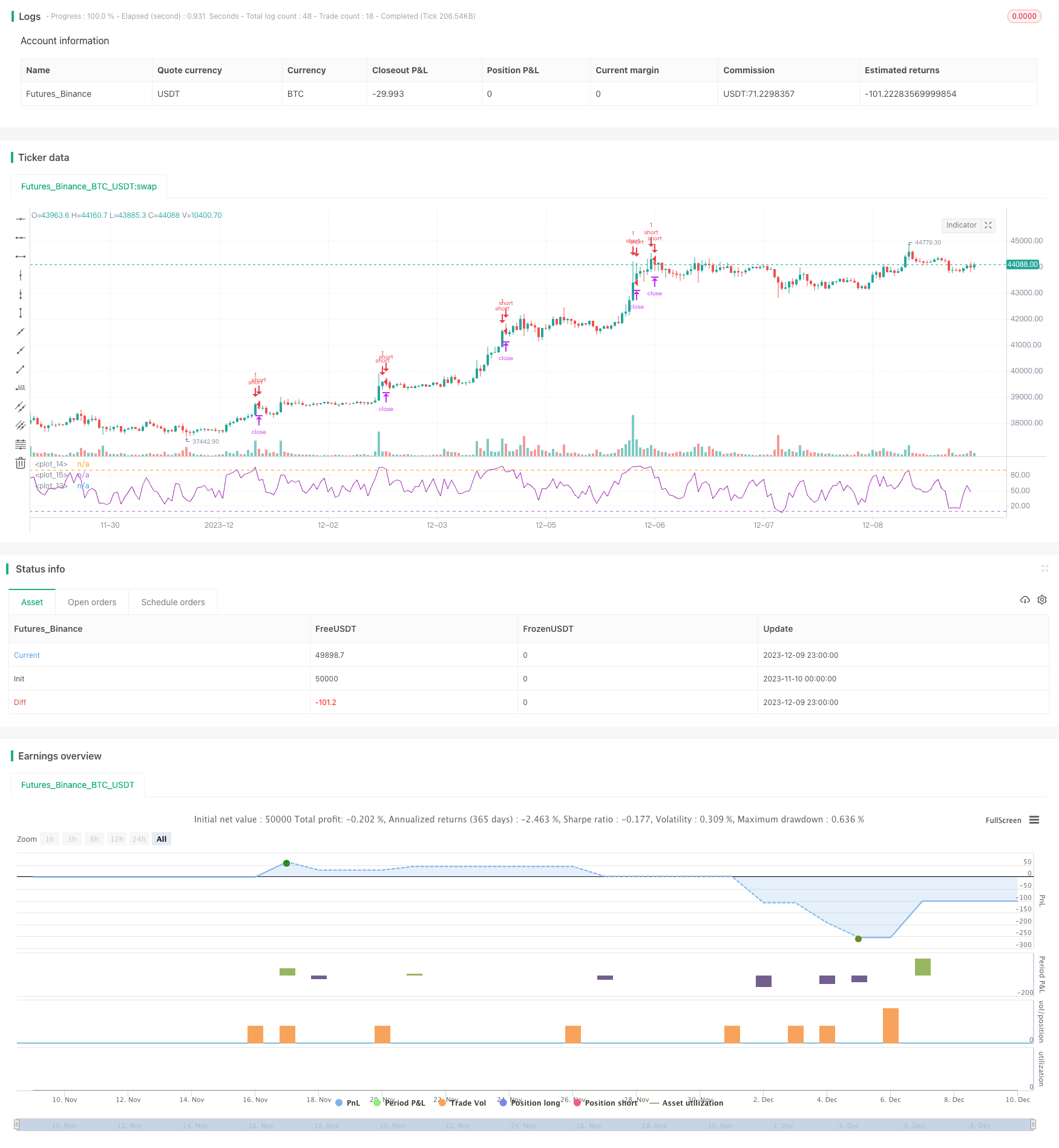
概述
本策略名为“RSI-MA 趋势跟踪策略”,其思路是同时利用 RSI 指标和 MA 均线来判断价格趋势和发出交易信号。当 RSI 指标超过设定的上下阈值时产生交易信号,而 MA 均线用来过滤假信号,在价格持续上涨或者下跌时才会发出信号。这可以在保持一定的盈利空间的同时有效过滤震荡行情。
策略原理
该策略主要使用 RSI 指标和 MA 均线。RSI 用来判断超买超卖,MA 用来判定趋势方向。 具体逻辑是:
计算 RSI 指标值,并设定上阈值 90 和下阈值 10。当 RSI 超过 90 时为超买信号,小于 10 时为超卖信号。
计算一定周期(如 4 日)的 MA 均线。当价格持续上涨时,MA 线上翘;当价格持续下跌时,MA 线下翘。
当 RSI 超过 90 同时 MA 线上翘时,做空;当 RSI 小于 10 同时 MA 线下翘时,做多。
止损设定为每手固定点数,止盈为每手固定百分比。
策略优势分析
该策略结合 RSI 指标和 MA 均线双重过滤,可以有效过滤震荡行情下的假信号。同时通过 RSI 的设置避免信号来得太晚,保证了一定的盈利空间。利用 MA 判定趋势方向,避免逆势交易。此外,策略参数较简单,容易理解和优化。
风险分析
该策略主要风险有:
突发事件造成暴跌或暴涨,RSI 和 MA 都没来得及反应,可能造成较大亏损。
震荡行情中,RSI 和 MA 可能频繁发出信号,造成过于频繁交易而增加交易费用和滑点成本。
参数设定不当也会影响策略表现,如 RSI 上下阈值设置过宽则信号延迟,设置过窄则信号太频繁。
优化方向
该策略可进一步优化的方向包括:
根据不同品种和周期参数进行测试和优化,设定最佳参数组合。
增加其他指标结合,如加入 KDJ、BOLL 等,设置更加严格的过滤条件,减少误交易概率。
设置自适应止损止盈机制,比如根据波动率和ATR 来动态调整止损价位。
增加机器学习算法,根据市场状况自动调整策略参数,实现参数的动态优化。
总结
该 RSI-MA 策略整体来说较为简单实用,同时结合了趋势跟踪和超买超卖判断,在良好的市场环境下能获得较好收益。但也存在一定概率的误交易风险,需要进一步优化以降低风险和提高稳定性。
/*backtest
start: 2023-11-10 00:00:00
end: 2023-12-10 00:00:00
period: 1h
basePeriod: 15m
exchanges: [{"eid":"Futures_Binance","currency":"BTC_USDT"}]
*/
//@version=2
//This strategy is best used with the Chrome Extension AutoView for automating TradingView alerts.
//You can get the AutoView extension for FREE using the following link
//https://chrome.google.com/webstore/detail/autoview/okdhadoplaoehmeldlpakhpekjcpljmb?utm_source=chrome-app-launcher-info-dialog
strategy("4All", shorttitle="Strategy", overlay=false)
src = close
len = input(4, minval=1, title="Length")
up = rma(max(change(src), 0), len)
down = rma(-min(change(src), 0), len)
rsi = down == 0 ? 100 : up == 0 ? 0 : 100 - (100 / (1 + up / down))
plot(rsi, color=purple)
band1 = hline(90)
band0 = hline(10)
fill(band1, band0, color=purple, transp=90)
rsin = input(5)
sn = 100 - rsin
ln = 0 + rsin
short = crossover(rsi, sn)
long = crossunder(rsi, ln)
strategy.entry("long", strategy.long, when=long)
strategy.entry("short", strategy.short, when=short)
TP = input(15) * 10
SL = input(23) * 10
TS = input(0) * 10
CQ = 100
TPP = (TP > 0) ? TP : na
SLP = (SL > 0) ? SL : na
TSP = (TS > 0) ? TS : na
strategy.exit("Close Long", "long", qty_percent=CQ, profit=TPP, loss=SLP, trail_points=TSP)
strategy.exit("Close Short", "short", qty_percent=CQ, profit=TPP, loss=SLP, trail_points=TSP)